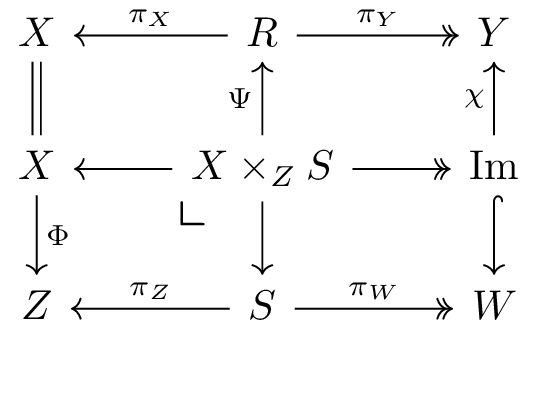Strong Reducibility as an Adaptor
In the previous post, I explained how Weihrauch reducibility could be viewed as a dependent lens. That was supposed to be the start of a few blog posts because my supervisor thought this work probably wasn't publishable. However, since then, we have written this up, and a preprint is available on the Arxiv. Even better, this work was accepted for CiE, as was an abstract for TYPES. I might still write some blog posts on various container constructions, but today I want to talk about the strong (or uniform) variant of Weihrauch Reducibility.
Recall from last time that we originally defined Weihrauch reducibility by
Let
There is a variant of Weihrauch reducibility called “Strong
Weihrauch reducibility”, which boils down to saying that our
backwards map doesn't depend on the original input at all, i.e.,
Fortunately, there are some very clever people at Strathclyde, particularly Jules Hedges, who explained how to do just this in a seminar talk, using what they have termed “Dependent Adaptors”.
What is a Dependent Adaptor?
Okay, slow down there. First, recall from last time that we swapped
thinking about partial-multivalued functions (relations)
Okay, what is a relation then?
If you are in a category with binary products, you might just say that a relation is a subobject or a product, but it pays to be a little more general than this and think internally. The important information about binary relations is that they have two projections and any given element of a relation depends uniquely on the result of both. Formally,
An (internal) relation from an object
In the previous post, we also wanted to restrict to surjective
functions to represent the idea that all elements of the domain should
have an answer. Originally, we said that we should work with
epimorphisms, but in the preprint, we changed our minds and decided we
should actually have pullback-preserving epimorphisms, which were
dubbed “answerable containers”. We want a similar kind of condition
on our relations. In what follows, we will work in a regular category
and require that
In a regular category
Now, can we define adaptors?
Yes.
Given problems 
Note that the arrows
The data
To see that this is the right definition, we will need to do some
unpacking. Just as last time, we will view the problem (relation)
as the type

The top left rectangle gives the equality
More formally, we can say we have a full & faithful functor from strong reductions to dependent adaptors and it wouldn't take much more work to get an equivalence.
The Strong Weihrauch degrees are isomorphic to the posetal reflection of the category of answerable containers and dependent adaptors over the category of projective represented spaces and (type 2) computable functions.
Is there a pattern to the definitions?
This is a very astute question. I will defer a full post on this for
another day, but the short answer is that lenses come about as a
result of taking the opposite of a fibration, see e.g. Streicher (Section 5). You can see this at play in papers like
Spivak's. In this view, dependent lenses
arise as the opposite of the codomain fibration and dependent adaptors from the fibration
That's all folks. I have two other posts half-written, and at some point will talk about the work on fixed points I've been doing with my supervisor.
